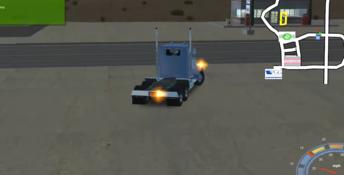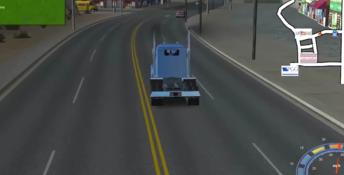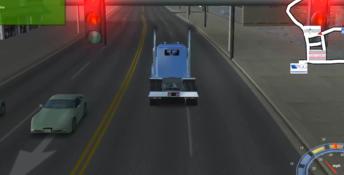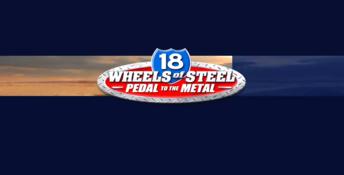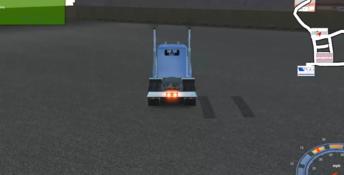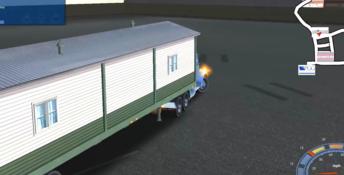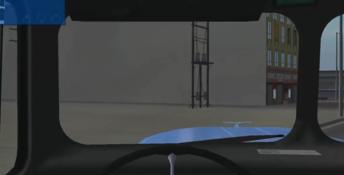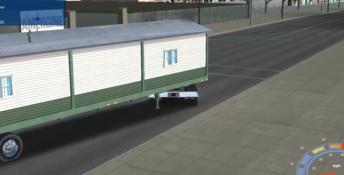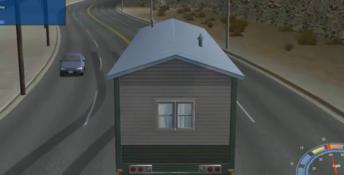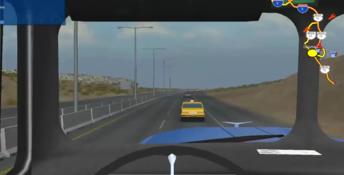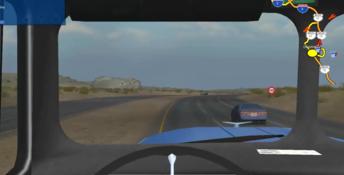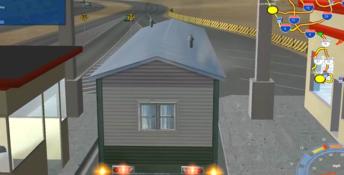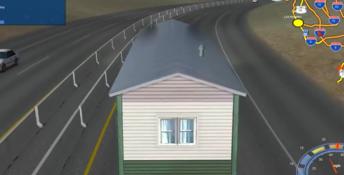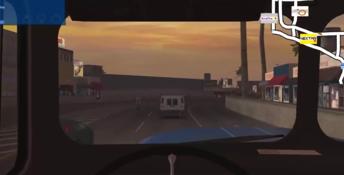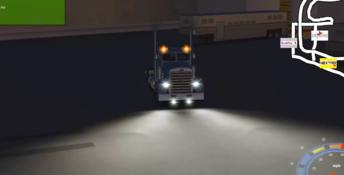18 Wheels of Steel: Pedal to the Metal
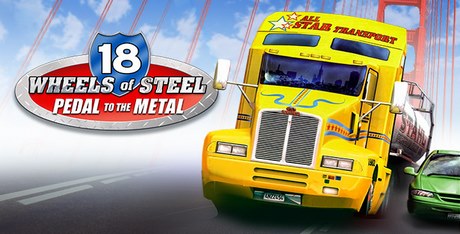
| a game by | ValuSoft, Inc. |
| Genre: | Racing |
| Platform: | PC |
| Editor Rating: | 7/10, based on 1 review |
| User Rating: | 7.3/10 - 6 votes |
| Rate this game: | |
| See also: | 18 Wheels |
Americans love cars. A few jeers greeted the first "horseless carriages", but the romance of the open road developed quickly. Today, just about everyone who isn't actually roaring down a highway is riveted to a video or computer system, driving everything from a dune buggy to a Ferrari.
Car contests appeared relatively late compared to other types of games. The limitations of early hardware made it hard to generate the rapidly scrolling graphics of road movement. Video-game makers tried overhead perspective on several cartridges for the Atari 2600 and Odyssey2 machines, but these games were entirely forgettable.
It soon became clear that players preferred first-person perspective to the top-down view Night Driver (Atari) finessed around the graphic problem by turning out the lights. The gamer saw little more than glowing road markers while driving down the twisting road. It did well in the arcades, so Atari followed up with a cartridge for the 2600.
Scott Orr's Baja Buggy, released by his Gamestar label for the Atari 800, gave automobile-loving video gamers something more intriguing to watch than the shadows of night. Pole Position (Atari) hit the arcades within a couple of months of the debut of Baja Buggy. Its huge success, as both a coin-op and a cartridge, cemented the popularity of driving contests in the video- and computer-entertainment field.
Drive, They Said
Test Drive (Accolade for most computers) was an overnight sensation when it was released toward the end of 1987. Unlike the myriad car games that preceded it, its first-person screen displays the dashboard and gear box as well as the winding mountain road ahead. The Distinctive Software programming group embellished this unusual behind-the-wheel perspective by actually showing the drivers working the gearshift from position to position.
Test Drive is one automotive simulation that treats driving as a subtle skill. Most arcade-style driving games permit the player to keep the vehicle at top speed from start to finish. Trying that in Test Drive earns a ticket from the Highway Patrol at best or a brief glimpse of the cracked windshield as it tumbles over the cliff.
It takes good reflexes and persistence to power to the top of the Rock. The course is divided into segments, though there is no utility for saving a partially completed run. The player has an enviable selection of classic sports cars to challenge the mountain, each precisely modeled after the real-life racing machines.
The Duel: Test Drive II (Accolade for most computers) pits a Ferrari F40 against a Porsche 959 in a head-to-head racing simulation patterned on the cockpit-oriented Test Drive. Of course, the computer will drive either car against the computerist if no human opponent is available.
Accolade has also released two disks which add cars and courses to the basic The Duel: Test Drive II. The Supercars gives racers a crack at the latest machines such as the '88 Lamborghini Countach 5000S and the '89 Corvette ZRI. In California Challenge, one or two computerists compete in a seven-part road race along the picturesque coast of California.
Out Run (Sega for most computers and the Sega Master System) is the biggest competition to Test Drive for the current title of top computer-driving game. It was a bonanza in the arcades, and editions for the Sega console and various home computers have enjoyed outstanding sales.
The original game put the player slightly behind the car, as in Pole Position, but much closer to road level. This ground-hugging view intensifies the sense of speed as the car roars up and down the hills. The home versions of Out Run can't equal the coin-op's roller coaster effect, but it's a praiseworthy attempt.
Horizontal stripes on the roadbed partially compensate for the slower, omni-directional scrolling routines on some home machines. The intricately detailed car, complete with a cute couple in the front seat, looks as good cornering as it does on the straight-aways.
Each segment of this five-part course is run against a countdown clock at the top of the screen. Completing a section before time runs out earns a bonus score for any surplus seconds. Between legs, a summary screen displays the car's progress toward the finish line.
The classic games often retain their appeal despite the passage of years, and Pole Position II (Mindscape for IBM PC and Atari 7800) is certainly a time-tested favorite. Fortunately, it has transferred very well from the amusement center to the home gaming screen.
As in the celebrated coin-op, a qualifying heat precedes the actual race. The faster the time, the better the pole position. Once the starter gives the signal, it takes fast reactions to thread a safe path through the heavy traffic of rival Formula 1 race cars.
Rad Racer (Nintendo for NES) includes eight courses from across the United States, including a difficult Los Angeles night run. This first-person perspective video game also provides an extensive range of cars that vary widely in performance characteristics.
Six different courses comprise the American Cross Country Prestige Cars Race in Crazy Cars (Titus Software for IBM PC, Amiga and Commodore 64). The solitary driver begins in Florida with a Mercedes 560. Completing a course before time runs out earns the driver better cars, including the Porsche 911, Lamborghini Countach or even a Ferrari GTO.
Each section of the course is raced against the time clock located at the top of the screen. Finishing before it reaches zero allows the computerist to progress to the next leg. Collisions with other cars and running off the road on turns cause the lengthiest delays.
Olivier Corviole's graphics are a little unusual, more impressionistic than realistic. The playfield shows a dashboard along the bottom of the screen, but the player still views in modified first-person perspective from a point slightly behind the vehicle. The drawings of the automobiles are exquisitely detailed, and the images hold together even during hairpin turns, often a problem with other driving games.
Crossing four states to complete a perilous mission is the goal in the newly released F40 Pursuit (Titus for IBM PC, Amiga, Atari ST and Commodore 64). The player drives a Ferrari F40 at speeds up to 200 miles per hour to elude hostile police and avoid standard road dangers.
The graphics, especially the other autos, look better than in the same publisher's Crazy Cars. The road fills the whole screen without the obstruction of a decorative dashboard at the bottom of the screen. Crashes that spin the F40 in a full circle are also a visual milestone.
Turbo Champion (Mastertronics for IBM PC) is a British-designed arcade racing contest that offers good value in the budget software category. Eight different race tracks, all packed with the expected assortment of oil slicks and dangerous debris, are included on the disk. And when the computerist gets tired of them, the Course Designer module can generate an unlimited number of new ones.
R.C. Pro-Am (Nintendo for NES), though a little out of the category, is sure to amuse many computer racers. The player steers a remote-control car around an extensive track shown in angled overhead perspective. The car can acquire enhanced powers by running over the bonus objects strewn all over the road. This dollop of adventure makes R.C. Pro-Am an exciting play-experience.
Leaving the Road Behind
Piles of rocks, wooden barriers and light poles are among the hazards that test steering ability in Speed Buggy (Data East for Amiga and Commodore 64). The player gets behind the wheel of an off-road vehicle, displayed in modified first-person perspective, and duels the clock on any of five tortuous courses.
If you want action, Speed Buggy doesn't skimp on the jouncing and bouncing. Bonus flags and gates build the score, but juicy prizes can lure the unwary into a succession of tight scrapes. The lively artwork balances varied scenery with excellent animation of the car.
Although Speed Buggy had strong sales in Europe, it has not done well in the U.S. so far. The Commodore edition, released first, did not come up to American software standards in graphics or play action.
Don't hold the defects of the C-64 disk against the new Amiga version, though. Britain's Elite Systems has translated the original coin-op into a playable and attractive arcade contest. It still doesn't push the hardware to its limits, but the Amiga Speed Buggy is a spirited treatment of off-road racing.
Epyx's 4x4 Off-Road Racing (IBM PC, Amiga and Commodore 64) has somewhat more depth than pure-action titles like Speed Buggy. Although the "beginner" setting lets players boot and boogie, veteran drivers pick a course, select a car and customize it with handy items like an extra gas tank, a winch or a camper body.
4x4 Off-Road Racing features four obstacle-strewn courses: Baja, Death Valley, Georgia and Michigan. Four vehicles - the Stormtrooper, Tarantula, Highlander and Katana - are rated for power, weight, gas mileage, endurance, ease of repair, payload with cap and fuel capacity. These factors strongly affect the race. A heavier truck, like the Stormtrooper, burns gas faster, but it really handles bumps from rocks, loose tires, competing racers and other hazards.
The driver then visits auto parts row to customize his vehicle with gear like deluxe tires, winches, extra-capacity fuel tanks and caps. Drivers who slam through other races at top speed are in for a shock. High speed is important, but it increases collision damage and wastes fuel.
Chase the Checkered Flag
Many driving games are races, at least nominally, but only a few simulate the total environment of professional auto racing. Pit-stop (Epyx, though it's no longer available) was the first home game to add touches like roadside stops for repairs to the basic driving scenario.
Pitstop's sequel, Pitstop II (Epyx for IBM PC, Apple II, Atari 800 and Commodore 64), is a refinement of the original design with one major addition: head-to-head competition capability. The horizontally split screen shows each driver a first-person view of the action.
Richard Petty and 18 other top pro drivers won't give the computerist a breather in Talladega (Cosmi for Commodore 64). As in Pole Position, the player races in a qualifying event to earn the best possible starting position. However, it includes elements, like pitstops and variable road conditions, not found in other games.
A more comprehensive simulation of big-time racing is Ferrari Formula 1 (Electronic Arts for most computers). The player customizes a Ferrari F1/86 and runs it on any of the 16 grand-prix circuit tracks against the world's top drivers.
After entering a few races, many compu-drivers will discover that the customizing process is virtually a game-within-a-game. The player can tinker with the fuel mixture and gear ratios, dump in a new engine or change the suspension. There's even a Ferrari test track to check out a new car before putting it into pro competition.
Five levels of skill keep Distinctive Software's Grand Prix Circuit (Accolade for IBM PC, Amiga and Commodore 64) challenging much longer than usual. At the higher levels, it takes more skill to brake and corner, and problems like spinouts and blown engines become more frequent.
In this game from the same design team that created Test Drive, the armchair speed demon drives the eight world-famous tracks. The computerist must join one of the three racing teams and earn a starting berth with a good showing in the qualifying run.
Those who complain that track racing is visually dull can wake up those jaded optic nerves with Vette! (Spectrum Holobyte for IBM PC, Amiga, Atari ST, Commodore 64 and Macintosh). It's a street-racing simulation that presents four courses in a beautiful San Francisco setting.
The graphics sharply separate Vette! from all other racing games. Rapidly scrolling, polygon-fill graphics let drivers motor through the streets of the West Coast metropolis and see many of the famous sights. This technology, developed for Spectrum's Falcon flight simulator, assures that players won't confuse Vette! with any other racing program.
Hot Rod (California Dreams for IBM PC, Amiga and Commodore 64) is a nostalgia-drenched salute to colorful, customized street machines like the '32 Ford Roadster or the '63 Chevrolet Corvette. Hot Rod evokes the total experience of being a hot rodder with a multi-module program that includes all major aspects of motor mania.
The player starts with any of 25 vintage cars and then adds from the 35 available performance parts. When the rod is ready, the player can cruise over to Bob's, where 15 rivals wait to challenge for the title of "King of the Road".
The computerist can customize the outside of the car as well as the inside. There is a choice of five paint jobs, plus special trim. California Dreams plans to market extra disks with more cars and locales to keep Hot Rod fresh.
Lombard RAC Rally (Top Ten Software for IBM PC, Amiga and Atari ST) spotlights a seldom-simulated type of racing, the road rally. The player, driving a Group A Ford Sierra RS Cosworth, braves all kinds of auto-destroying terrain in a re-creation of this English rally. Detailed cockpit graphics show the hands of the driver and navigator as they manipulate the vehicle's controls and monitor its progress through the course.
Another feature of Lombard RAC Rally is the workshop. The readouts of important information and an excellent schematic of the car help make it easy for the computerist to repair and upgrade it. It is a well-executed design that offers a distinct change-of-pace from the usual driving-game play mechanic.
The Checkered Flag
There are already more driving games than any article could possibly cover. That won't stop publishers from rolling additional ones off the software assembly line in 1990. As long as the real car makers manufacture glamorous new machines, new programs will put computerists behind the wheel.
Future driving games will continue the trend toward greater depth and complexity. Games like David Wolf Secret Agent (Dynamix for IBM PC) and Beverly Hills Cop (Box Office for most computers) have extensive driving segments, but the automotive action is placed within a larger context. So-called "driving adventures" could become a hot craze by the end of next year.
Download 18 Wheels of Steel: Pedal to the Metal

System requirements:
- PC compatible
- Operating systems: Windows 10/Windows 8/Windows 7/2000/Vista/WinXP
